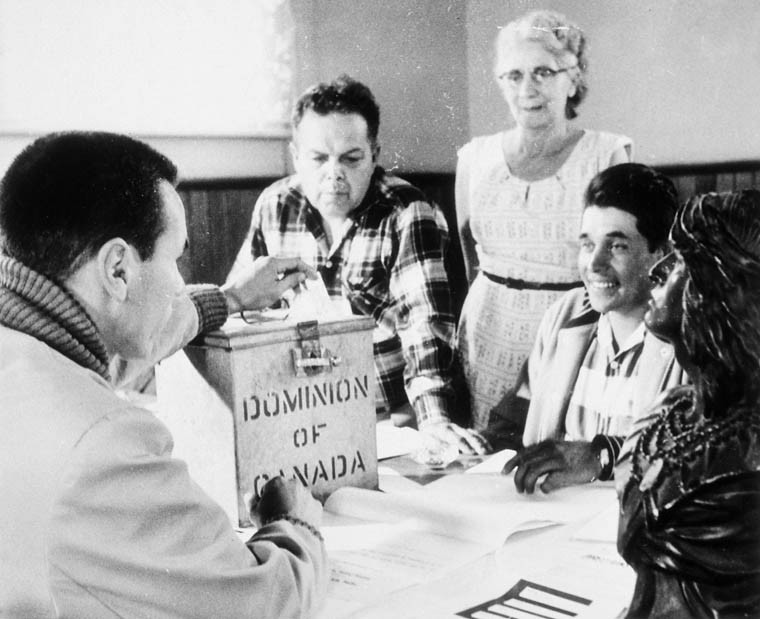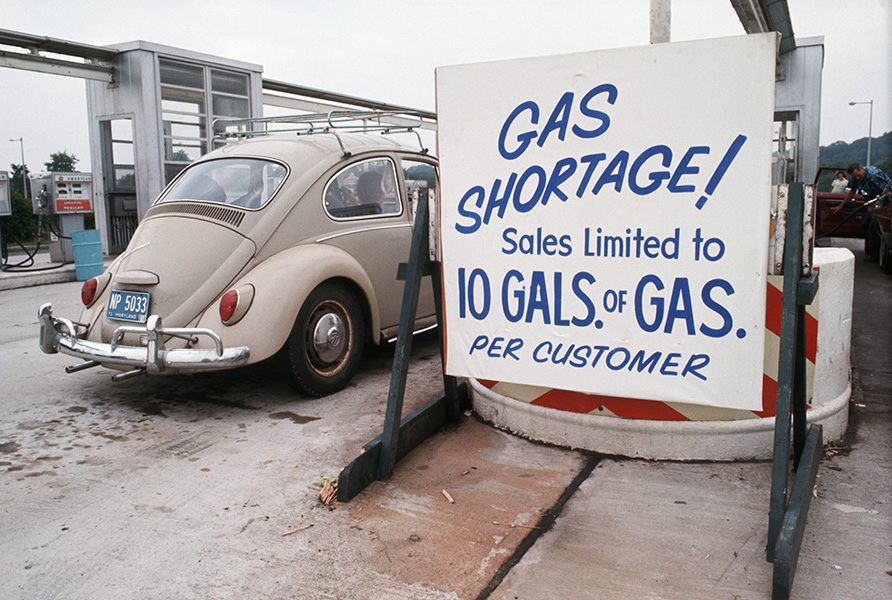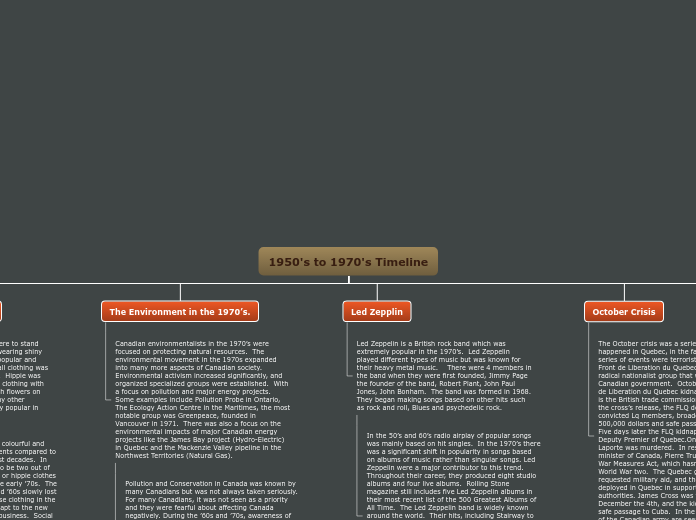1950's to 1970's Timeline
Aboriginal People Given the Right to Vote in Federal Elections
July 1st of 1960 the prime minister John Diefenbaker gave the right for aboriginals to vote in federal elections. The Canada elections act was pushed through legislation and parliament. The act was to allow Canadian aboriginals the ability to vote in federal elections without having to give up their identity as aboriginal. Before the change in 1960, British North America act in 1867 allowed aboriginals to vote only if they gave up their aboriginal status.
The elections act was not widely discussed by Canadian citizens who did not have relations with Aboriginal people. Aboriginal people gained additional exposure and power in federal elections. The election act allowed every Canadian citizen an equal right to vote. Consequently, Aboriginals had a better opportunity to have their priorities respected and listened to through the election process. Canada was one of the first countries to give Aboriginals peoples an equal say in Government elections. The voting rights of all Canadian citizens are now enshrined in the Canadian Charter of Rights and Freedoms. The picture in the slide shows Aboriginals of the Rice Lake band, near Peterborough voting after enfranchisement for the first time.

"First nations Right to Vote Granted 50 Years Ago. CBC News." 1 July 2010, https://www.cbc.ca/news/canada/north/first-nations-right-to-vote-granted-50-ye
ars-ago-1.899354
TBT. (20 Oct, 2016). (First Nations People Granted the Right to Vote in 1960) (Website). New
Journeys Articles.
https://newjourneys.ca/en/articles/tbt-first-nations-people-granted-the-right-to-v
ote-in-1960
Canada-U.S. Auto Pact Agreement
The Auto Pact deal was made in 1965 between Canada and the United States. The pact was signed by Prime minister Lester Pearson and President Lyndon Johnston. The reason behind this pact was so Canada could increase production and lower the costs of cars. This was to make a stronger economy that relied on the car industry. The auto pact removed tariffs from both sides of the border so vehicles could be shipped freely. Also it insured that there would be a constant growth of employers in the car industry so the employment and job rate would not fall to 1964 an all time Canadian low.
The auto pact involved many Canadian, American politicians and auto workers. The consequences were a free trade agreement covering the auto industry. The agreement resulted in lower prices and increased vehicle production in Canada, expanding the workforce up to 30 percent. The deal was in place for 36 years until it was replaced by the North American free-trade agreement (NAFTA). International free trade agreements are now in place between many nations. The picture is a Canadian vehicle assembly plant in the 1970's. Under the auto pact vehcles from Canada could be sold in the U.S tariff-free.

Crane. D. (2006, February 6). Canada-US Auto Pact . The Canadian Encyclopedia.
https://www.thecanadianencyclopedia.ca/en/article/canada-us-automotive-products-ag
agreement
CBC/Radio Canada (n.a) (The Auto Pact: En Route to Free Trade) (Website). CBC/Radio
Canada. https://www.cbc.ca/archives/topic/the-auto-pact-en-route-to-free-trade
Fashion trends in the 1970s
In the 1970’ the new fashion trends were to stand out and look new. The movement of wearing shiny disco ball clothing became extremely popular and wearing hippie trend clothing. Disco ball clothing was commonly shiny, metallic, and sparkly. Hippie was different where they wore loose-fitting clothing with bright colours that typically had childish flowers on them. These trends were worn in many other countries in Europe but were extremely popular in the United States and Canada.
The fashion trends in the ’70s were colourful and outlandish, unlike the prior movements compared to the more conservative trends in past decades. In North America, there was thought to be two out of every four people would wear disco or hippie clothes more than three times a week in the early ’70s. The earlier fashion trends in the ’50s and ’60s slowly lost interest, and businesses selling those clothing in the previous decades were forced to adapt to the new modern dress, or they went out of business. Social demographic, it became a norm that one should know or wear trendy clothing. If you didn't, then it was thought you were not cool or fashionable. Like rock and roll and pop music advanced, commonly disco balls were apart and used at many concerts and events. This gave the disco balls a cool reputation and the same idea transferred to disco-inspired clothing. The picture in the next slide shows the fashion many people would wear in the 1970s. The bright colours were very common to stand out and look unique.

What to Know About 1970s Fashion. Central Casting. (2020, September 25).
https://www.centralcasting.com/what-know-about-1970s-fashion/
Park, M. (8 Dec. 2018). (Groovy 70s Disco Clothing for Fans and Costume Parties). (Photgraph)
Well Done, Stuff.
https://welldonestuff.com/groovy-70s-disco-clothing-for-fans-and-costume-parti
es
The Environment in the 1970’s.
Canadian environmentalists in the 1970’s were focused on protecting natural resources. The environmental movement in the 1970s expanded into many more aspects of Canadian society. Environmental activism increased significantly, and organized specialized groups were established. With a focus on pollution and major energy projects. Some examples include Pollution Probe in Ontario, The Ecology Action Centre in the Maritimes, the most notable group was Greenpeace, founded in Vancouver in 1971. There was also a focus on the environmental impacts of major Canadian energy projects like the James Bay project (Hydro-Electric) in Quebec and the Mackenzie Valley pipeline in the Northwest Territories (Natural Gas).
Pollution and Conservation in Canada was known by many Canadians but was not always taken seriously. For many Canadians, it was not seen as a priority and they were fearful about affecting Canada negatively. During the ’60s and ’70s, awareness of the harmful effects of pollution and destruction of natural resources became much more widespread. As a consequence, Government funding and economic priorities shifted towards environmental protection. This remains a high profile issue in Canadian society today, where the focus is now on the impact of climate change. Environmental policies are a significant factor in political elections in Canada. Environmentalism in the 1970’s caused the protection of the environment to be a big topic in the media and in politics today. The picture below shows the three Greenpeace activists who helped form the Canadian political Green party.
Hammel, M (2010, February 21). (Enviromental Movement in Canada) The Canadian
Encyclopedia.
https://www.thecanadianencyclopedia.ca/en/article/environmental-and-conserv
ation-movements
CTV News. (15 Sept 2011). (Greenpeace Marks 40th Anniversary in Vancouver) (Photograph).
CTV News
https://www.ctvnews.ca/greenpeace-marks-40th-anniversary-in-vancouver-1.69
7971
Led Zepplin
Led Zeppelin is a British rock band which was extremely popular in the 1970’s. Led Zeppelin played different types of music but was known for their heavy metal music. There were 4 members in the band when they were first founded, Jimmy Page the founder of the band, Robert Plant, John Paul Jones, John Bonham. The band was formed in 1968. They began making songs based on other hits such as rock and roll, Blues and psychedelic rock.
In the 50’s and 60’s radio airplay of popular songs was mainly based on hit singles. In the 1970’s there was a significant shift in popularity in songs based on albums of music rather than singular songs. Led Zeppelin were a major contributor to this trend. Throughout their career, they produced eight studio albums and four live albums. Rolling Stone magazine still includes five Led Zeppelin albums in their most recent list of the 500 Greatest Albums of All Time. The Led Zeppelin band is widely known around the world. Their hits, including Stairway to Heaven and Whole Lotta Love, has been listened to by millions of people worldwide and continue to be popular music downloads. Led Zeppelin inspired many other artists and bands such as Queen in the UK, the Beastie Boys in the U.S. and Rush from Canada. The pictures in the next slide is Led Zeppelin in concert. From left to right the band members are Robert plant (Lead Vocals), John Paul Jones (Bass Guitar), John Botham (Drums) and Jimmy Page (Lead Guitar).

Fast. S (n.a) Led Zepplin. Encyclopedia Britannica.
https://www.britannica.com/topic/Led-Zeppelin
Aswad. J (5 Oct. 2020). (Led Zeppelin Wins Stairway to Heaven’ Copyright Battle as Supreme
Court Refuses to Hear Case) (Photograph). Variety.
https://variety.com/2020/music/news/led-zeppelin-win-stairway-to-heaven-copyr
ight-1234792866/
October Crisis
The October crisis was a series of events that happened in Quebec, in the fall of 1970. These series of events were terrorist attacks done by the Front de Liberation du Quebec (FLQ), which is a radical nationalist group that wasn’t pleased with the Canadian government. October 5th 1970 the Front de Liberation du Quebec kidnapped James Cross who is the British trade commissioner. In exchange for the cross’s release, the FLQ demanded the release of convicted Lq members, broadcasting their manifesto, 500,000 dollars and safe passage to Cuba or Algeria. Five days later the FLQ kidnapped Pierre Laporte, the Deputy Premier of Quebec.One week later Pierre Laporte was murdered. In response, the Prime minister of Canada, Pierre Trudeau, reinstated the War Measures Act, which hasn’t been used since World War two. The Quebec government also requested military aid, and the Canadian army deployed in Quebec in support of the civil authorities. James Cross was finally released on December the 4th, and the kidnappers were granted safe passage to Cuba. In the picture below soldiers of the Canadian army are seen arriving to provide support to the civil authorities in Quebec. f

Mclntosh, A. (2013, August 13). October Crisis. The Canadian Encyclopedia.
https://www.thecanadianencyclopedia.ca/en/article/october-crisis
Fidler, R (25 Oct, 2020). (Remembering Quebec’s October Crisis) (Photograph). Canadian
Dimension.
https://canadiandimension.com/articles/view/remembering-quebecs-october-cri
sis
The summit series of 1972
The 1972 Summit series was an eight-game series between a team of Canadian national hockey league stars and the national team of the Soviet Union (U.S.S.R). The games took place in four different Canadian cities, and the final four games were played in Moscow. Team Canada was expected to outperform the Soviet team but found themselves with only one win and a tie after five games. They overcame a hostile environment in Moscow to win the final three games. In the last game of the series, Canada won on a late tie-breaking goal by Paul Henderson. At this time, hundreds of thousands of Canadians and thousands of Russians were fixated on the Summit series.
The Summit series was widely notable by Canadians and Russians. This event was significant to Canadian culture because hockey is a national sport known and played by many Canadians. With political tensions with the U.S.S.R, this hockey series became an even more intense battle of power and superiority. After the summit series, international hockey involving professionals from the NHL became more routine. Then eventually, professional players were allowed to compete for their country in the Olympic games. Team Canada overcame at home and especially in Moscow, which earned them the Canadian team of the century. In this photo members of Team Canada and the Soviet national team exchange a postgame handshake.

Zweig, Eric. (2006, Febuary 7). 1972 Canada-Soviet Hockey Series (Summit Series). The Canadian Encyclopedia.
https://www.thecanadianencyclopedia.ca/en/article/1972-canada-soviet-hockey-series
Brophy, M. (5 August. 2016, 2:45 pm). (Remembering the 1972 Summit Series). (Photograph)
Ontario Minor Hockey Association.
https://www.omha.net/news_article/show/676446-remembering-the-1972-summ
It-is
The high oil shocks in the ’70s
The high oil prices in the 1970s are due to two events that led to oil shortages and high prices—the Yom Kippur war in 1773 and the Iranian revolution in 1979. The Yom Kippur war was between Israel and the Arab countries Egypt and Syria. Following the war, other Arab countries like Saudi Arabia implemented an embargo on oil shipments to the western countries that supported Israel. This included Canada and the United States. As a result, there was a dramatic increase in crude oil prices and significant petroleum product shortages, leading to economic recessions in many western countries. Another dramatic rise in oil prices and shortages followed the Iranian revolution of 1979, when the supply of oil from Iran was seriously disrupted.
The global impact was very widespread because of the heavy dependence on oil as a source of energy. Energy conservation became an essential priority, as did energy independence. In 1980 the Canadian Federal Government announced the National Energy Program to promote Canadian energy independence. While it had some success, it did cause a significant rift in provincial relations, particularly with Alberta. Some of these difficulties persist even today. The picture below is an example of a typical gasoline rationing that occured frequently during the oil price shocks of the 1970's.

Bregha, F. (2006, February 7). Energy Policy. The Canadian Encyclopedia.
https://www.thecanadianencyclopedia.ca/en/article/energy-policy
Corbett, M (22 Nov, 2013). (Oil Shocks 0f 1973-1974) (Photograph). Federal Reserve History.
https://www.federalreservehistory.org/essays/oil-shock-of-1973-74
